Useful tips about tires
The GB-01 chassis is made for Off-Road usage, thus the pin spike rear tires and ribbed tires at the front. As my model will be mostly or only driven on carpet, the pin spike tires do not provide enough grip and the front tires don't perform better on this surface. Hopefully, the TamTech series offers more possibilities:
![]() Tarmac usage:
Tarmac usage:
40137 GB-01T Front Rims

40139 GB-01T Front Tires
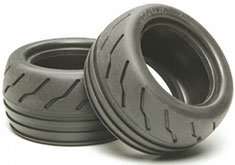
40138 GB-01T Rear Rims
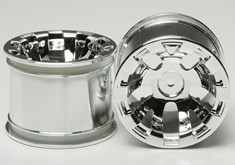
40140 GB-01T Rear Tires
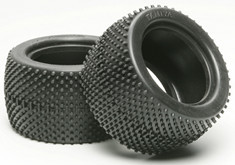
40174 GT-01 Front Rims
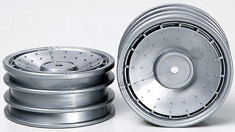
40533 GT-01 Hi-Grip Front Tires
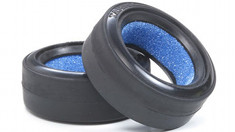
40175 GT-01 Rear Rims
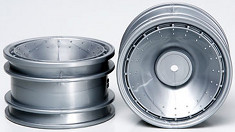
40534 GT-01 Hi-Grip Rear Tires
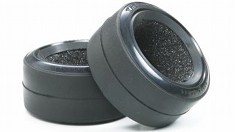
The major issue with GB-01T wheels is their look: they are much wider and a little bit bigger than the stock ones. In addition, these tires can only be used with these rims.
You can also use GT-01 chassis wheels: the Hi-Grip tires proved to provide excellent grip. But these wheels being noticeably smaller than GB-01's, the overall model look will be affected (just like any buggy wearing On-Road wheels though).
![]() Tarmac and carpet usage:
Tarmac and carpet usage:
40155 GB-02 Front Tires

40156 GB-02 Rear Tires

40542 GB-02 Front Tires (SC)
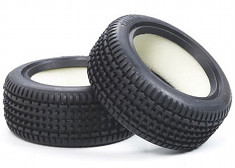
40543 GB-02 Rear Tires (SC)
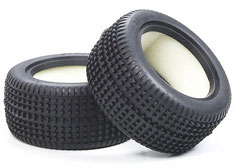
The GB-02 tires belong to the TamTech Buggy Champ: the first ones are the "stock" tires (reference 40155 & 40156), and the second set comes with foam inserts (reference 40542 & 40543, SC means "Soft Compound"). The last set is recommended to run on carpet since these tires provide a lot of grip. The GB-02 tires can be used with any of the following rims:
40109 white front rims
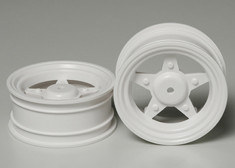
40110 white rear rims

40552 chrome plated front rims
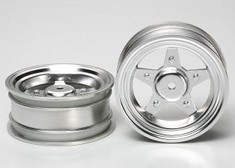
40553 chrome plated rear rims
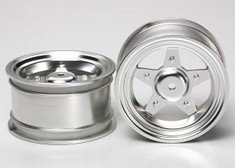
40133 gold plated front rims
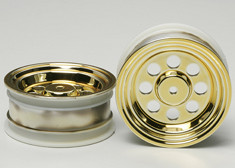
40134 gold plated rear rims
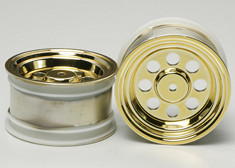
40160 white front rims

40161 white rear rims
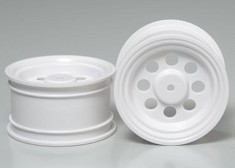
The first set of rims is the stock set for The Frog, The Hornet and the Desert Gator: they are also available in chrome plated (special version not used by any model in stock form). Next row, the gold plated rims come from The Fox and the white rims come from the GB-01 chassis kit: from my personal experience, these are the most solid of all. Not shown, the gray colored rims from the Buggy Champ are also compatible. All these rim sets can be fitted with any GB-01 tire set (except GB-01T's) and GB-02's.
![]() Another alternative option:
Another alternative option:
40152 GT-01 Chassis D Parts Tree

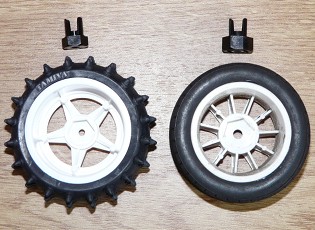
M-Chassis wheel fitted
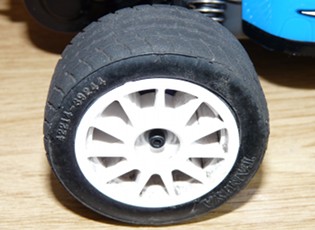
OK, some explanations ![]() .
.
1st photo: this is the D Parts Tree from the GT-01 chassis. At the bottom, you can see 2 pairs of 12mm hexa and 2 other pairs of 10mm hexa. Only the last ones are used on TamTech chassis: Tamiya gives no clue why these 12mm hexa are there since they are not used by any model. But they do exist.
2nd photo: here we have a GB-01 wheel with its 10mm hexa and an M-Chassis 60D wheel with a 12mm hexa. This M-Chassis wheel directly comes from my Suzuki Swift: dimensions are the same as the GB-01 rear wheel. At the front, the diameter is the same but the M-Chassis wheel is wider than the GB-01's.
3rd photo: the M-Chassis wheel is fitted on my GB-01. Voilà ![]() .
.
Thanks to these 12mm hexa, you can fit any 1/10th wheel set on a TamTech Gear chassis. Beware not to fit too big wheels though, especially for off-roading: the bigger the wheel, the heavier and more difficult to handle by the gearings and the motor. Moreover, the central hole diameter of an M-Chassis rim is 4mm whereas the long screw acting as a wheel axle on TamTech chassis is 2.6mm diameter: this results in a play. Even if it seems like invisible, it could lead to fast wear or even a break. As I couldn't test this solution for a long-term usage, I would recommend caution since I have no idea about possible side effects on mechanics.
Tamiya TEU-102BK speed controller
Several concerns can arise with an RTR kit ESC when you want to use another receiver, or a battery pack different from the recommended NiMH. Potential issues can be:
- the BEC feature
- LiFe or LiPo cut-off
Carefully reading the TEU-102BK manual will answer these questions. The BEC issue will arise whenever you replace the stock TRU-02 receiver with a 2.4GHz unit. The BEC is a system that converts the electrical voltage delivered to receivers and servos: these electronic components operating voltage range is between 4.8 and 6 volts. As the BEC logo engraved on it states, the TRU-02 receiver features this voltage regulation. However, none of the 2.4GHz receivers feature the BEC system.
Here are the TEU-102BK specifications and how to connect it as per the manual:
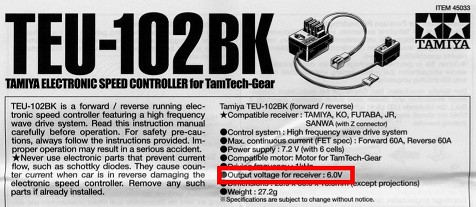
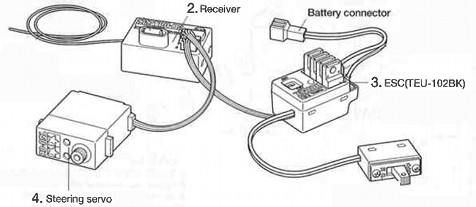
The wiring instructions show the battery pack connects to the TEU-102BK ESC that connects to the receiver to which the servo is connected. Electrically, the battery pack powers the ESC that powers the receiver that powers the servo. In concrete, the battery pack voltage is 7,2V and every subsequent component is powered with this voltage... when the receiver and the servo can only tolerate up to 6V.
This is why there is a BEC system into the TSU-02 receiver: the receiver tolerates the 7.2V voltage and the integrated BEC system converts it into 6V to supply the steering servo. So far, so good.
When replacing the TRU-02 with a 2.4GHz unit, you remove the BEC system from the equation. Which means supplying 7.2V to the steering servo, which is a 20% over its maximum tolerance. So, let's have another look to the TEU-102BK manual: no BEC specification. However, the red boxed text shows the receiver's output voltage is 6V: bingo!
Conclusion: you can replace the TRU-02 with a 2.4GHz unit without any risk for the receiver and the steering servo since the TEU-102BK ESC will supply them with a 6V voltage. So why doesn't the ESC show the BEC logo too? No idea ![]() . The reason might be in an extra feature of the BEC system: some BEC systems also feature a cut-off when the voltage is too low. This cut-off allows the few remaining voltage to only supply the receiver and the servo: this way, the motor can't drain anymore current, but the steering still works so you can keep control of the model. This low voltage cut-off may be mandatory for a component to wear the BEC logo, which would explain with the TEU-102BK doesn't show it. Anyway, problem solved: you can use any receiver to replace the stock one if you want. The rest of the electronics will be safe.
. The reason might be in an extra feature of the BEC system: some BEC systems also feature a cut-off when the voltage is too low. This cut-off allows the few remaining voltage to only supply the receiver and the servo: this way, the motor can't drain anymore current, but the steering still works so you can keep control of the model. This low voltage cut-off may be mandatory for a component to wear the BEC logo, which would explain with the TEU-102BK doesn't show it. Anyway, problem solved: you can use any receiver to replace the stock one if you want. The rest of the electronics will be safe.

I wrote the word "cut-off" just above: this is a very important question when using LiFe or LiPo battery packs (even if I am not personally concerned). Below a certain remaining voltage, these battery packs get damaged or can even burst into flames. These battery packs require an automatic cut-off before they fully discharge. This is what is called "LiFe Cut-Off" or "LiPo Cut-Off" when available in ESC specifications.
As for the TEU-102BK, there is no cut-off, either for LiFe (cut-off at 2.2V per cell) or LiPo (cut-off at 3V per cell): you will need to use a separate cut-off. By the way, please note the minimum voltage for LiFe and LiPo are different: a LiFe cut-off can NOT be used for LiPo battery packs.




